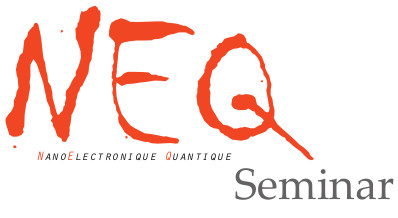- Accueil
- Institut Néel
- Équipes de recherche
- Pôles & Services techniques
- Travailler à l’institut
- Partenariats
- Actualités
- Agenda
- Annuaire

Résumé/Abstract : When the strength of Coulomb interaction between itinerant electrons in a two-dimensional system becomes significantly larger than the kinetic energy, the electrons start to develop strong correlations. A paradigm phase that is expected to emerge in this regime is an electronic Wigner crystal, in which the electrons spontaneously form a periodic lattice mimicking that of atoms in the real crystals. However, in order for this electronic crystallization to occur, the actual ratio of the above energy scales must exceed 30, which turns out to be notoriously difficult to fulfill in conventional semiconductors (e.g., GaAs). Recently, atomically-thin transition metal dichalcogenides (TMDs) have emerged as a highly-tunable experimental platform that unlocks the access to uncharted territories of strongly correlated electron physics. This is due to reduced dielectric screening and large carrier effective masses, which endow TMD monolayers with excellent optical properties and give rise to strong inter-electron interactions enabling to reach Coulomb-to-kinetic energy ratios being more than an order of magnitude larger than that for the GaAs at comparable electron densities. In this talk, I will review our recent optical investigations of landmark correlated phases in charge-controlled TMD-based van der Waals heterostructures. In particular, I will present our novel spectroscopic technique enabling us to detect the Wigner crystal in a TMD monolayer through the periodic potential it generates for the excitons (1). In the presence of this potential, the excitons Bragg scatter off the Wigner crystal, which gives rise to the emergence of a Bragg-umklapp resonance in the reflectance spectrum that heralds the presence of an electronic lattice. Our observation of this resonance provides the first unequivocal evidence for the formation of the Wigner crystal that has been thus far probed only by indirect methods in two-dimensional systems. In the second part of the talk, I will also show how the Rydberg excitons in a TMD monolayer can be exploited to optically probe the formation of correlated electronic phases in an adjacent graphene layer (2), which is otherwise optically inaccessible owing to the lack of a robust energy gap. I will demonstrate that this approach allows for sensing fractional quantum Hall effect in graphene with a similar sensitivity to that of state-of-the-art transport tools.
References: (1) T. Smolenski, P. E. Dolgirev, C. Kuhlenkamp, A. Popert, Y. Shimazaki, P. Back, X. Lu, M. Kroner, K. Watanabe, T. Taniguchi, I. Esterlis, E. Demler, and A. Imamoglu, Nature 595, 53-57 (2021). (2) A. Popert, Y. Shimazaki, M. Kroner, K. Watanabe, T. Taniguchi, A. Imamoglu, and T. Smolenski, Nano Letters 22, 7636 (2022)
